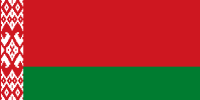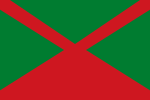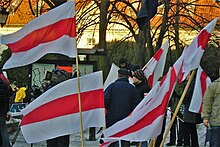Flag of Belarus
| Flag of Belarus | |
|---|---|
 |
|
| Vexillological symbol : |
|
| Aspect ratio: | 1: 2 |
| Officially accepted: | June 7, 1995 |
The current flag of Belarus was adopted on June 7, 1995 after a referendum and modified on February 10, 2012. It replaced the white, red and white flag that was the national flag after the country's independence from the Soviet Union and is now used by sections of the opposition .
description
The national flag follows more closely the appearance of the flag of the former Belarusian Soviet Republic (BSSR). Only the hammer and sickle are not shown.
The decorative pattern on the left edge is an ornament embroidered in 1917 by the farmer Matrona Markewitsch, which became known as the “rising sun”. On the grounds that it was a typical motif of the Belarusian folk costume, it was inserted into the new flag of the then BSSR in 1951 and adopted as a negative image, i.e. in the reverse color, for the flag of the Republic of Belarus introduced in 1995.
After the referendum on the introduction of the current state symbols in 1995, a competition was called in which citizens around the world were called upon to retrospectively ascribe a "comprehensive interpretation of the meaning and meaning of the [...] current symbols of the Republic of Belarus [...]" to the new flag. Through a collaboration between participants in the competition and the jury, which included the head of the state heraldry committee, two historians and an artist, the colors of the flag were retrospectively assigned the following meaning: The color red is “the color of the victory of the Belarusian troops with Grunwald , the Red Army and the partisans who liberated Belarus from the fascists and collaborators. ”Green“ embodies hope, spring and a new beginning and is the color of the Belarusian forests ”.
More flags
Belarusian DOSAAF
Historical flags
prehistory

The origin of the white-red-white flag lies in the history of the Grand Duchy of Lithuania . Legend has it that, during a battle, a wounded prince used his blood-soaked white cloth tied around his head as a banner to lead his troops. The color white is interpreted as a symbol for the human spirit and red as a symbol for the blood of Jesus Christ . Some researchers report that the flag was used by the Lithuanian cavalry during the Battle of Orsha in 1514, but this is controversial.
1917 to 1919
After the abdication of the Russian Tsar Nicholas II in 1917, a white-red-white flag designed by the architect Klawdi Stepanowitsch Dusch-Duschewski was introduced for the newly created Belarusian People's Republic . The colors come from the traditional figure of the pahonja - a white knight in a red field.
With the declaration of independence of March 25, 1918, the Belarusian National Committee declared the decision as follows: Due to the fact that Belarusian folk art is dominated by white and red ornaments, these colors should be used in the Belarusian national flag. The committee decided that the flag should consist of three horizontal stripes: white, red and white of equal widths and that the length should be twice the width.
1919 to 1937
After a successful communist coup in 1919, a solid red flag was first introduced for the Lithuanian-Belarusian SSR . With the emergence of the sole Belarusian SSR, the golden initials "SSRB" in Cyrillic letters were added in the upper left corner . From 1919 to 1925, the government-in-exile of the Belarusian People's Republic used a white-black-red-black-white striated flag.
 ? 1919
? 1919
1937 to 1951
In 1937 the letters were twisted into "BSSR" and the flag was expanded to include a golden hammer, a golden sickle and a red star. In the 1940s these symbols were removed and a gold border was added instead.
During the German occupation in World War II , the use of the white-red-white flag and the Pahonja coat of arms was permitted. As a result, collaborationist institutions such as the Belorussian Central Council or the Beloruthenian Youth Office use this flag, which meant that the Soviets were subsequently able to find reasons for political speculation about these symbols. However, the developer of the white-red-white flag himself, Klaudsij Szjapanawitsch Dusch-Duschuski , refused to cooperate with the German authorities, so that he was arrested in 1943 and taken to a concentration camp - also for supporting Jews .
1951 to 1991
On December 25, 1951, the BSSR introduced a new flag designed by Russian artist Mikhail Gusew. This was similar to today's one, but the hammer and sickle with a star could be seen in the red field in the top left; there was no symbol on the back of the flag. In contrast to today's flag, the ornament appeared white on red instead of red on white.
1991 to 1995
Shortly before the collapse of the Soviet Union , on September 19, 1991, the white-red-white flag became the national flag of Belarus again. With the election of President Aljaksandr Lukashenka in 1994, a socialist course was sought again and so a year later new state symbols were introduced that are strongly reminiscent of the Soviet era.
 ? The flag proposed by Lukashenka (1995) was not implemented
? The flag proposed by Lukashenka (1995) was not implemented
Since 1995
In 1995, following a referendum, Belarus reverted to a flag design that largely corresponded to the last flag of the Belarusian SSR. The differences were that the red star, hammer and sickle were no longer used, and the color of the ornament (red on white instead of white on red). This design was valid until the publication of the Decree СТБ 911-2008 and differs from the one valid today only in that the ornament now completely fills the stripe on the left edge, while until 2012 the ornament is one twelfth of the length, the stripe one ninth Length.
There has been a flag dispute since 1995 : the opposition to the Lukashenka presidency, especially the national democratic camp, rejects the current flag and instead continues to display the old white, red and white. The same applies to the coat of arms, whereby the opposition uses the traditional pahonja (rider with sword) instead of the official, Soviet-looking emblem as the national symbol.
See also
literature
- Dmitri Semuschin: Coat of arms and state symbolism of the Belarusians from the Middle Ages to the present day. In Rainer Lindner: Handbook of the history of Belarus. Vandenhoeck & Ruprecht, Göttingen 2001, pp. 49-66.
Individual evidence
- ↑ Elena Temper: Visualize Belarus. State symbolism and nation building since 1990. Böhlau Verlag, Vienna, Cologne, Weimar 2012, p. 168 .
- ↑ Elena Temper: Visualize Belarus. State symbolism and nation building since 1990. Böhlau Verlag, Vienna, Cologne, Weimar 2012, p. 170 .
- ↑ The flag of Belarus on minsktours.by
- ↑ a b c d National Symbols in Belarus: the Past and Present. (No longer available online.) In: belarusdigest.com. March 6, 2010, archived from the original on December 26, 2016 ; Retrieved December 26, 2016 . Info: The archive link was inserted automatically and has not yet been checked. Please check the original and archive link according to the instructions and then remove this notice. (English)
- ↑ Дуж-Душевский Клавдий Степанович (accessed December 19, 2016).
- ↑ Dmitri Semuschin: Coat of arms and state symbolism of the Belarusians from the Middle Ages to the present day. 2001, p. 62.
- ↑ Ingo Petz: New beginnings through music - cultural counter-elite in Belarus. In: Eastern Europe No. 1/2007, pp. 49–56, on p. 51.
- ↑ Boris Meissner: Ukraine and Belarus in the transformation. An interim balance. Verlag Wissenschaft und Politik, 2001, p. 134.
Web links
- Flags of the World (English)
- Regulations about the national Flag of Belarus (1995) on wikisource (English)





















